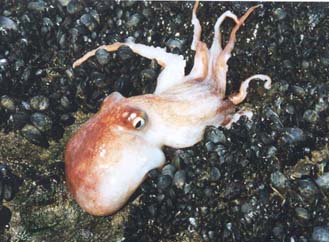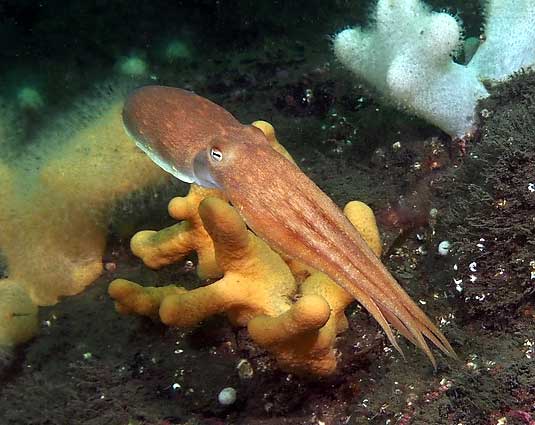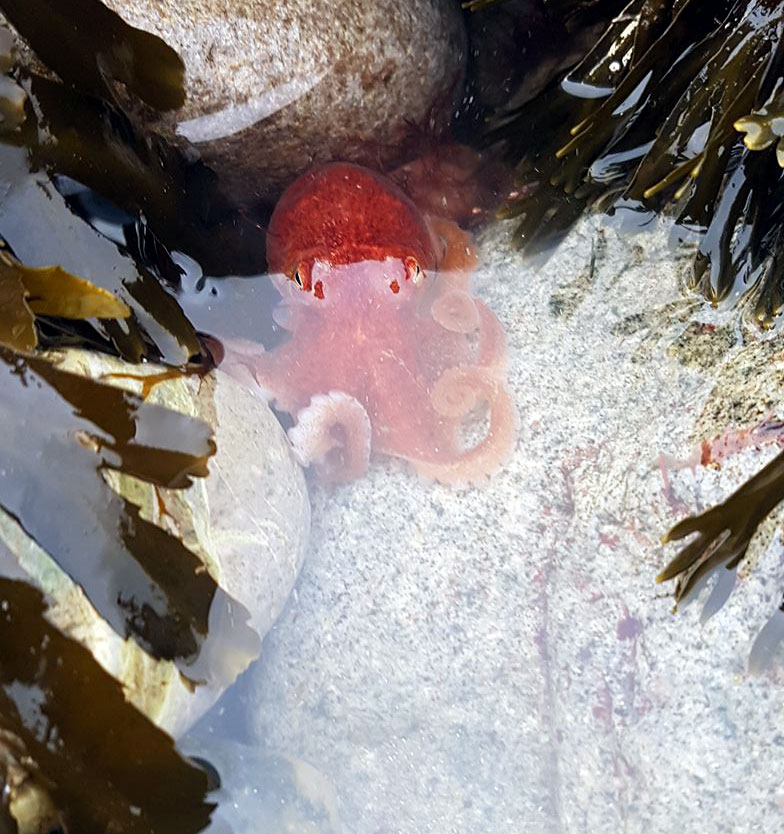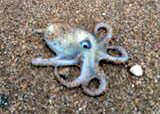
 |
Octopuses & other Cephalopods
Cephalopoda contains the nautiluses; cuttlefishes, squids, and octopuses.
1)
They are the most advanced of all the invertebrates.
2)
They move by jet propulsion, squirting water from a funnel.
3)
They are the most intelligent of the invertebrates, with a capacity for
learning.
4)
Most of them are able to eject ink to confuse predators.
5)
Most of them have a remarkable ability to change colour.
6)
They have arms with suckers which they use to capture prey. (Octopuses
have eight arms, squids have ten).
7)
They have a hard beak to tackle prey with hard shells like crabs.
8)
Their heyday was 100 million years ago in Cretaceous
times when Ammonites were plentiful in the oceans of Earth.
9)
Although they are molluscs, most of them have
evolved to have only a diminished internal shell (the cuttlebone of the
cuttlefish), or have lost their shell completely (octopus).
10)
The Giant Squid, Architeuthis, is the largest invertebrate known,
and stretched out with its tentacles included, it has attained 18 metres
in length. Even larger specimens may await to be discovered in the deepest
oceans.

Curled Octopus, Eledone cirrhosa
Curled
Octopus,
Eledone
cirrhosa
Photograph
by Peter Bardsley
The
Curled
(or Lesser) Octopus, with a single row
of suckers, is the species most likely to be found the British Isles, with
a highly variable presence. In some years we receive reports throughout
the year and in other years reports are few and far between. This octopus
preys on crabs and other
crustaceans
and can even enter lobster pots to consume the
catch.
 |
by Peter Bardsley on flickr Click on the swimming octopus for the gallery of more undersea life from St. Abbs, Berwickshire, SE Scotland. |
When disturbed octopuses will swim backwards rapidly by jet propulsion.
May
- June 2022
There
have been numerous reports of the Common
Octopus, Octopus
vulgaris, in Cornish seas and brought
in by fishing vessels.
22
February 2020
A
large Common Octopus, Octopus
vulgaris, was washed ashore dead at
Wembury,
south Devon.
6
June 2018
Common
Octopus
Octopus
vulgaris
Photograph
Gallery by Philip
Shinton
At the depth of ten metres off the Dorset coast I discovered my first Common Octopus, Octopus vulgaris, in thirty years of diving. This was a very large octopus, at tip to tip about two metres long and his head was about double the size of a rugby ball. It seemed about as big as me. Octopuses are usually nocturnal, but this one was active in the daytime.
The
Common
Octopus is most easily identified, if discovered
in the English Channel, by having two rows of suckers. A hearsay report
says they were all wiped out in the cold winter of 1963.
This octopus
is a southern species at its northern biogeographical limit in winter off
British coasts.
22
October 2017
Quickly
following on was storm "Brian" with gale force winds up to Force
9 around the British Isles with various
creatures washed up on the shore, including
a large
whale
under the cliffs at Flamborough, Yorkshire.
Other
notable strandings occurred included hundreds of young Curled
Octopuses, Eledone
cirrhosa,
(also called the Lesser Octopus
with a single line of suckers) found on the shore at Trefor,
Llýn
Peninsula, north Wales and many areas over a widespread coasts of Wales
including
Aberystwyth
and
Telacre as well
as the north Devon coast and further afield as well.
 |
 |
"Loads of young Curled Octopuses, Eledone cirrhosa, were washed up at Treforbeach, north Wales, after the storm. I managed to put all the stranded ones I saw back in the water."
 |
Curled Octopuses are orange when alive and healthy but will lose their colour under stress before they die out of the water. This one was discovered on the shore at Crow Point, Braunton, north Devon. Octopus changing colour (video link) by Gordon Hughes |
| 25
March 2012
Discovered stranded by the receeding equinoctial spring tide, this Lesser Octopus, Eledone cirrhosa, was high and dry at Llandudno on the north Wales coast.. I dug a shallow depression underneath it which filled with water, allowing it to breath. Initially the pupil was almost closed, but got larger after about ten minutes. "I was amazed how it could change colour and shape, and the feeling of the tentacles gripping my fingers was quite strange. Anyway, after a brief photoshoot, I'm happy to say she was free to carry on chasing crabs and lobsters." |
 |
5 December 2009
A
Common
Octopus, Octopus vulgaris, was
washed up dead on Salthouse
Beach, North Norfolk after a week of strong northerly winds and quite
rough seas, resulting in a variety of finds along the shoreline.
The octopus was
found by local diver Rowley Nurse
whilst walking his dog along the shore.
9
July 2009
Commercial
crab and lobster fisherman Clive Brown
brought me a live Common Octopus, Octopus
vulgaris, which he landed in one of his
pots to the north-west of Les
Hanois Lighthouse
, south-west of Guernsey,
Channel
Islands, at 10:00 am.
This octopus was missing one arm. The injury had healed.
 |
All
reports of Octopus vulgaris
in Channel Island waters are of interest because of their virtual disappearance
after the cold winter of 1962/ 1963.
They began to re-appear in small numbers several years ago and then disappeared
again. Clive Brown reports one being caught in the same location as his
capture by another fisherman five years ago. They may move in from deeper
water to the west of Guernsey.
Octopus
vulgaris has two rows of suckers per arm
and grows to a much larger size than Eledone
cirrhosa, which has one row of suckers
per arm.
5 June
2009
Commercial
fisherman Rick Ferbrache
caught a Common Octopus, Octopus
vulgaris, one mile off the Rousse headland,
off the north-west coast of Guernsey.
All reports of Octopus vulgaris in Channel Island waters are of interest because of their virtual disappearance after the cold winter of 1962/ 1963. They began to re-appear in small numbers several years ago and then disappeared again. Clive Brown reports one being caught in the same location as his capture by another fisherman five years ago. They may move in from deeper water to the west of Guernsey.
Octopus vulgaris has two rows of suckers per arm and grows to a much larger size than Eledone cirrhosa, which has one row of suckers per arm.
1
March 2009
An
unusual octopus was captured in a shallow water net off Brittany, France,
by Nick
Praed on the "Silver
Dawn" fishing out of Newlyn, Cornwall.
 |
 |
Richard Young from Hawaii suggested Haliphron atlanticus.
Yes,
I concur with Dick that that looks like a Haliphron.
It's pretty shallow for a Haliphron.
Normally they hang out somewhere between 200 and 2000 metres (not that
we have huge amounts of data for them). There are quite a few records
for western Atlantic and fewer for eastern Atlantic but I think that's
probably a reflection of research effort rather than anything else.
There was quite a large one caught of the west of Ireland last year.
The females grow very large (see: http://news.bbc.co.uk/1/hi/sci/tech/1898313.stm
for a huge specimen caught off New Zealand) and the Irish one was a relatively
big one and made the local press. I tried to find the web page for
you by googling but unfortunately I can't find it.
There's
a bit of info on the occurrence of this species further north:
Collins,
M.A., Brown, E. & Pierce, G.J., 1995. The octopus Haliphron
atlanticus Steenstrup in Shetland waters.
Shetland
Naturalist, 1, 123-124.
They're
interesting little things and not a whole lot is known about them.
Males are very small: your specimen may well be a male. You can tell
by the arms. Like other cephalopods they have a modified third arm
in the male for delivering sperm, but in Haliphron it's kept in a little
sac under the eye, so males look like they've only got 7 arms, instead
of the regulation 8. It's this character that is one of the reasons
we know it's related to other weird cephalopods such as Agonauta
(also known as the Paper Nautilus), Ocythoe and Tremoctopus
(the blanket octopus).
Dr
Louise Allcock
Co-editor,
Journal of Natural History
Adjunct
Lecturer, Martin Ryan Marine Science Institute, Galway
Honorary
Senior Lecturer, Queen's University Belfast
+353
(0)91 495868
NAFC
Marine Centre: 7-armed Octopus
13
February 2009
Three
Curled
Octopus,
Eledone
cirrhosa, were caught by commercial
fisherman Shane Petit
from on one of the Casquet banks to the west of Alderney in the Channel
Islands. Shane Petit
caught another Eledone cirrhosa
on Longue Bank
south
of Sark on 7 February 2009.
He found another one in the stomach of a Conger
Eel he caught the same day off St. Martin's
Point, Guernsey. He caught a third one whilst fishing on the Casquets bank
on the night of the 12 February 2009.
This
octopus is scarce in the Channel Islands but a common species in the seas
north of the English Channel. The southern species, the Common Octopus,
Octopus
vulgaris, which grows much larger, plagued Guernsey shellfish fisheries
until its demise locally during the cold winter of 1962
- 1963.
3 Match
2008
A hexapus,
or six-legged version of the Lesser or
Curled Octopus,
Eledone
cirrhosa, was captured in a lobster
pot off the coast of north Wales and put on show at the Anglesey
Sea Zoo. It was only then it was discovered to
have only six legs instead of the normal eight, and this may have a result
of a birth defect rather than an accident. It was been claimed as a world's
first as nobody seems to discovered one before. Its fame meant it was transferred
to the Blackpool
Sea Life Centre to attract a bigger audience.
In Saundersfoot, south Wales we found a Lesser or Curled Octopus, Eledone cirrhosa. It was very much alive and although stranded by the receding tide, when placed in a nearby deep rock pool where it became quite active, changing colour.
21
March 2002
About
twenty dead Lesser Octopuses, Eledone cirrhosa, were scattered
over a stretch of about 200 metres of Killiney beach, Co. Kerry,
Ireland. The tentacles/arms were about 15 cm long.

17
November 2001
A
Curled
Octopus was discovered by Helen
Nott on Heacham Beach, Norfolk, In this
clear photograph, you can see the single row of suckers. The Common Octopus
has a double row.
15
October 2000
A
Curled
Octopus over 1 kg in weight was caught off Roker Pier, near Sunderland,
NE England.
15
May 1999
Dr
Peter Tannett discovered the photographed
Curled Octopus
whilst on a field meeting with the Yorkshire Naturalists' Union on rocks
just above low water at Ravenscar, North-east Yorkshire on Saturday 15
May 1999.

Dr. Daniel Latrouite (IFREMER Centre de Brest) wrote:
Common Octopus
Photograph © by Richard Lord (Guernsey)
Three
Common
Octopuses were also reported from Cornwall
during the first weeks of November 2002.
4
October 2002
A
Guernsey fisherman caught a large Common
Octopus, Octopus vulgaris, in a
crab pot about half a mile from Hanois Lighthouse off the south-western
tip of Guernsey. The octopus had devoured at least two edible
crabs and one lobster. The fisherman
estimated the total length at about 1.5 metres and the tentacle length
at 1 metre. He estimated the weight at 4.5 to 5.5 kg (10 to 12 lb).
He returned the octopus to the sea.
Another
Guernsey fisherman caught a large Octopus vulgaris in July
2002.
Sea
surface temperatures at the entrance to St. Peter Port harbour, Guernsey
have been about 1.5° C warmer since early August than the average sea
surface temperature for the last 20 years. The sea at the entrance
to St. Peter Port harbour has been warmer in every week this year than
the average temperature for the past twenty years. The highest sea temperaure
occurred on 2 October 2002
at 17.8° C compared to the mean of 16.7° C.
13
August 2002
One
large Octopus vulgaris was caught south of Plymouth and landed
on the Plymouth Fish Market.
May
2002
A
Common
Octopus,
Octopus vulgaris, was
caught three quarters of a mile at Chapel Point off Mevagissey, Cornwall,
and presented to Mevagissey Harbour Marine
Aquarium.
25
March 2002
A
Common
Octopus, Octopus vulgaris, in Plymouth Fish Market. This one
was not notified, so maybe they are getting commoner in the seas off the
south-west?
31
October 2001
Fisherman
Steve
Long caught a Common
Octopus,
Octopus
vulgaris, off the Cornish coast off Coverack in deepish water at about
75 metres (40 fathoms). This warm water octopus is now only rarely discovered
in the English Channel, although within just about living memory it was
commoner. This species was identified by Paul
Gainey and it will go to the Blue
Reef Aquarium in Newquay.
October 1998

A large Common Octopus, Octopus vulgaris, was brought into Plymouth
Aquarium. It
was believed to have been caught off the extreme south-west of Cornwall.
The
Common Octopus has been rare in British seas for nearly 40 years, apparently
since the
cold winter of 1963.
The Looe boats also brought in a Squid measuring over 2 metres from the
beak to the
tail, excluding the tentacles. The species was not identified. (Jon
Makeham Report).
25
June 1999
A
Common
Octopus,
Octopus vulgaris, was seen by a diver off off Dodman,
Cornwall (SX 0039).
It was a metre across. Common Octopuses are only rarely discovered even
off the south-western coasts. However, in the past, before the cold winter
of 1963, they may have been commoner.
On February 2, 1999 I picked up a specimen of Octopus vulgaris from a local crab fisherman who was potting a few miles south-east of Guernsey. The octopus weighed 4051 grams but Right arm III and IV were missing part of their length and Left arm I, II, III, & IV were missing part or all of their length. Total length of octopus to tip of right arm I was 129 cm.
These are the only two Octopus vulgaris I have come across during my 6 years in Guernsey although there may have been a couple of other local captures.
Octopus
species
Identification
guide for shelf cephalopods in the UK waters (North Sea, the English Channel,
Celtic and Irish Seas)
Squid
Eggs masses (Sussex coast)
Cornish
Marine Wildlife Reports 1999 (by Ray Dennis)
Cornish
Marine Wildlife Reports 2000 (by Ray Dennis)
Cornish
Marine Wildlife Reports 2001 (by Ray Dennis)
3 January
2002
A
deep water trawler after Blue Ling and Hake etc. caught a female Giant
Squid, Architeuthis dux, amongst the large haul of fish. With
a mantle length of 127 cm it is a medium-sized specimen with some of the
tentacles missing. Therefore, the total length could not be measured, but
it is estimated to be about 5.5 metres with a weight of about 60 kg. the
specimen will be prepared for display at the National
Marine Aquarium, Plymouth, ‘Creatures of the Deep' zone from
May
2002.
This
is believed to be the 25th Architeuthis recorded in British waters since
1673. Fifteen have been stranded on the shores of the British Isles,
nine caught in fishing gear and one found in the stomach of a Sperm Whale.
There have been nineteen species of Architeuthis described but it is unlikely that there are more than seven, and most recent work suggests that there are three species - Architeuthis dux in the north Atlantic, Architeuthis martensi or japonica in the northern Pacific and Architeuthis sanctipauli in the Southern Ocean. However DNA studies have so far been carried out on only two specimens, one from New Zealand and one from Newfoundland (Atlantic coast of Canada), and the results so far published show no significant differences between them.
According to the Guinness Book of Records 1991, the largest squid found in British seas was an Architeuthis monachus found at the head of Whalefirth Voe, Shetland Isles on 2 October 1959. Its total length was measured at 7.31 metres (24 ft).
However, details of this
record may be called into question as it is included in the List
of British & Irish Strandings in year 1949 with a mantle length
of 1.2 metres.
On this list the largest
measured specimen had a mantle length of 1.75 metres and was stranded in
Cove Bay, Aberdeen on 8 January 1984. (My estimate of the total length
would be nearer 6.7 metres or 22 ft.)
The world's largest species is Architeuthis dux.
Architeuthis:
News Report
Architeuthis:
the Giant Squid
CephBase
Full
Report (Aberdeen University)
EuroSquid
Bobtail
Squid,
Rossia
macrosoma.
|
|
|
|
|
News 2018 |
Membership Form |
|